This is a beautiful New Year’s Eve soap recipe. I gave it a pink and white swirl for an elegant look throughout the bar, for continued beauty throughout the use of the soap.
And just for fun, add champagne! Really, the only reason I would add champagne is as a fun gift idea. The small amount of sugars in the champagne also add an extra bubble effect, but that can be done more cheaply with honey or castor oil. But adding champagne just makes this a fun (and beautiful) gift.
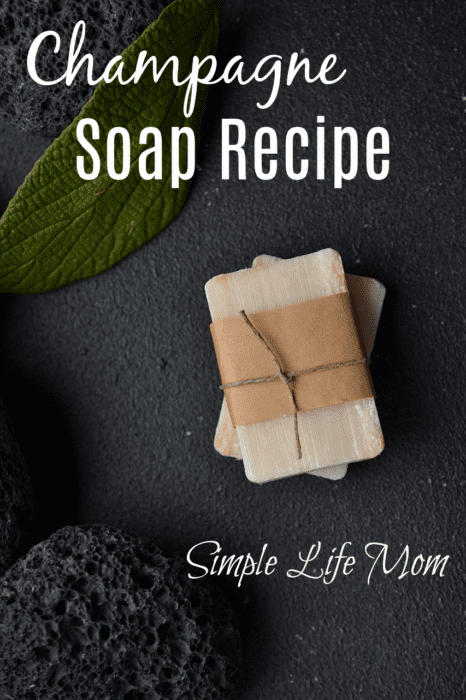
Alcohol in Soap
Whenever you add alcohol into a soap recipe, you must keep in mind the effect of the sugars. Sugars add bubbles to soap, but they also add heat. Whether you are using sugar cane, honey, milks, or alcohols that have sugars like beer, wine, or champaigne, you need to watch for over heating.
Overheating soap will get simultaneously very dark and translucent. Soap that is becoming extremely hot will even start to crack. I’ve never witnessed it, but I’ve also heard of soap boiling up like a baking soda and vinegar volcano and lava science fair experiment if it gets extremely over heated.
These things are easy to watch for though. I’ve made soap with “hot” essential oils like clove and cinnamon bark, honey, and milks, or even soap like this with wine or beer and not had any problems because I’ve taken a few steps. Here are my suggestions:
- Chill the champagne first. This will ensure that the lye doesn’t scorch the sugars and will keep the soap a lighter color.
- Don’t insulate the mold. Most house temperatures are not cold enough to stop the saponification process. The heat in the soap will be enough to finish the process without any problems. If you are concerned about the corners of your mold becoming cold and not gelling, then wrap a towel around the sides of the mold. Cover it, but don’t pt a blanket or layers of towels over and under it.
- If it starts to darken more than normal gelling darkness, remove the lid. If you’re still concerned, place it in the fridge for a little while.
- Don’t combine hot essential oils with high sugar recipes. You can with extra care, but if you’re a little nervous about over heating, then choose cooler oils that don’t tend to cause heating (and never fragrance oils. Not only are they not healthy, but they tend to cause a lot of problems in soap making).
Color and Scent
I’ve used two clays to add color to this soap. It’s already a creamy soap, but removing a small amount and adding rose clay will give it the pink swirl. Removing a small amount and adding the kaholin clay will add a different level of white swirl into the creamy color.
If you want to make the entire soap pink with white swirls, instead of creamy with pink and white swirls, then just remove some for the white and add pink into the main batch. You have options. Play around and make it your own.
I’ve added a rose and lemon scent to this soap. You can just add rose, or add another scent combination that fits who you are and your preferences. Some great ideas are:
- patchouli lavender
- lavender vanilla
- peppermint lime
- cedarwood lime
- frankincense sage
- ylang ylang peppermint
- grapefruit geranium
The combinations are endless, but you can see that when i combine scents I often combine a deeper scent with a lighter scent (base notes vs top notes). This helps the scent to hold out longer in the soap so you can still smell it months later.
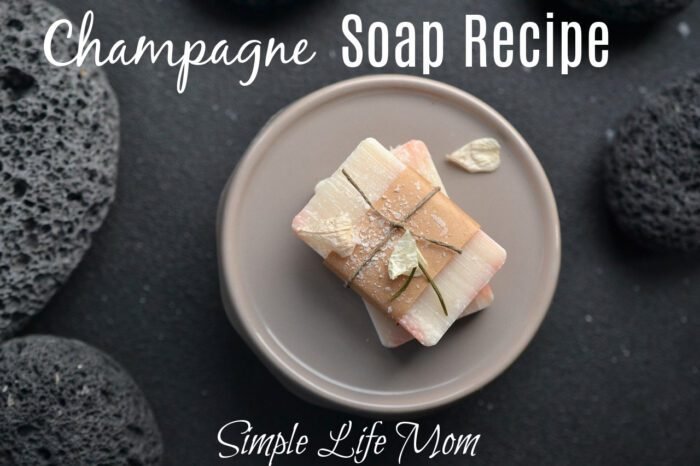
Gift Ideas
The Champagne soap really is a great gift idea. If you’re looking for more holiday soap recipes, I’ve got you covered. Here’s another list of resources for you:
- Fall Soap Recipes
- 5 More Soap Recipes
- 3 Fall Soap Recipes
- Christmas Soap Recipes
- 6 Christmas Soap Recipes
- Apple Cider Soap Recipe
- 12 Christmas Gift Ideas
- Last Minute Gift Ideas
I also have a lot of great gifts in my shop: Simple Life Mom Shop.
Champagne Soap Recipe
You’ll need a set of equipment to get started. Make sure you have a scale, saucepan, measuring spoons, glass or plastic bowls, large stirring spoon, large stainless steel pot, small zip top bag, thermometer, mold, parchment or wax paper, stick blender, whisk, and rubber spatula.
Makes: 3 lbs or 12 four ounce bars.
Superfat Content: 10%
Ingredients:
- 10 ounces champagne (reduced to 5 ounces)
- 6.6 ounces filtered water
- 8 ounces coconut oil
- 5 ounces avocado oil
- 5 ounces castor oil
- 5 ounces apricot kernel oil
- 5 ounces sweet almond oil
- 5 ounces beeswax
- 4 ounces lye
- 0.75 ounce rose essential oil (3% dilution)
- 0.50 ounce lemon essential oil
- 3 teaspoons rose clay
- 1 Tablespoon kaolin clay
Directions:
- Pour 10 ounces champagne into a saucepan and allow to sit at room temperature for 24 hours. It’s very important for all of the carbonation to be gone. After 24 hours, heat champagne over low heat. Simmer for 15 minutes and allow to return to room temperature.
- Prepare mold by adding lining if necessary.
- Add water to champagne and place in the freezer until it is slushy, but not frozen solid. This doesn’t have to be exact, as the lye will melt it either way.
- Combine coconut, avocado, castor, apricot, sweet almond oils, and beeswax in a large stainless steel pot. Heat until coconut and beeswax is melted and then cool oils to around 90 degrees Fahrenheit.
- Put on full safety gear: gloves, long sleeve, charcoal mask (regular masks do absolutely nothing). Weigh lye crystals into a zip-top plastic bag. Go outside with champagne water and pour lye crystals over the top and stir until all lye crystals are dissolved. allow to cool until around 90 degrees Fahrenheit.
- Pour lye water into pot of oils and mix with hand mixer on and off until light trace. This is at the beginning of when it starts to thicken. For more details click here.
- Add essential oils of your choice (usually a total of 1 ounce is a good amount for this size batch).
- Remove 1/2 cup of soap into one bowl and another 1/2 cup into another bowl. Add rose clay to one and kaolin clay to the other. Whisk until there are no lumps. Add more clay if necessary.
- Pour main soap batch into mold. Drizzle back and forth the pink and then the white. Insert a dowel rod or kabob skewer to the bottom of the mold and pull back and forth in the opposite direction of your drizzles.
- Cover. You don’t need to insulate unless your house is below 65 degrees Fahrenheit. Then I would advise light insulation. Watch for over heating. Because of the heating process of the champagne at the beginning, this should not be an issue.
- Remove from the mold after 24 hours, cut and then cure for 3-6 weeks.
I hope you enjoy this recipe. It’s fun and beautiful. Let me know how it went for you and any ideas you have.


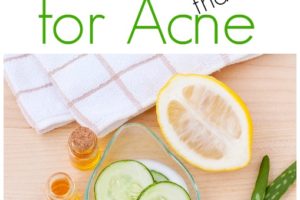
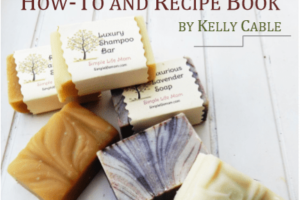
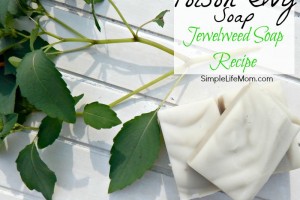
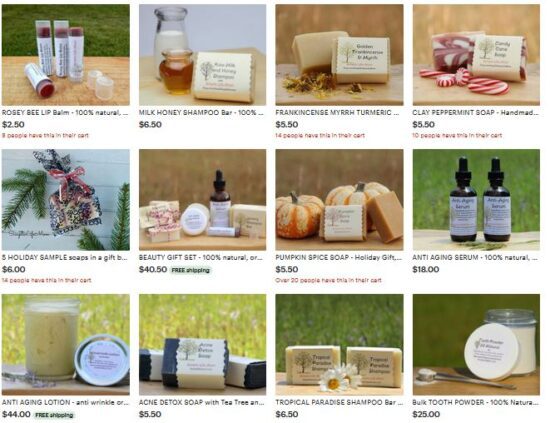
7 Comments
Leave your reply.